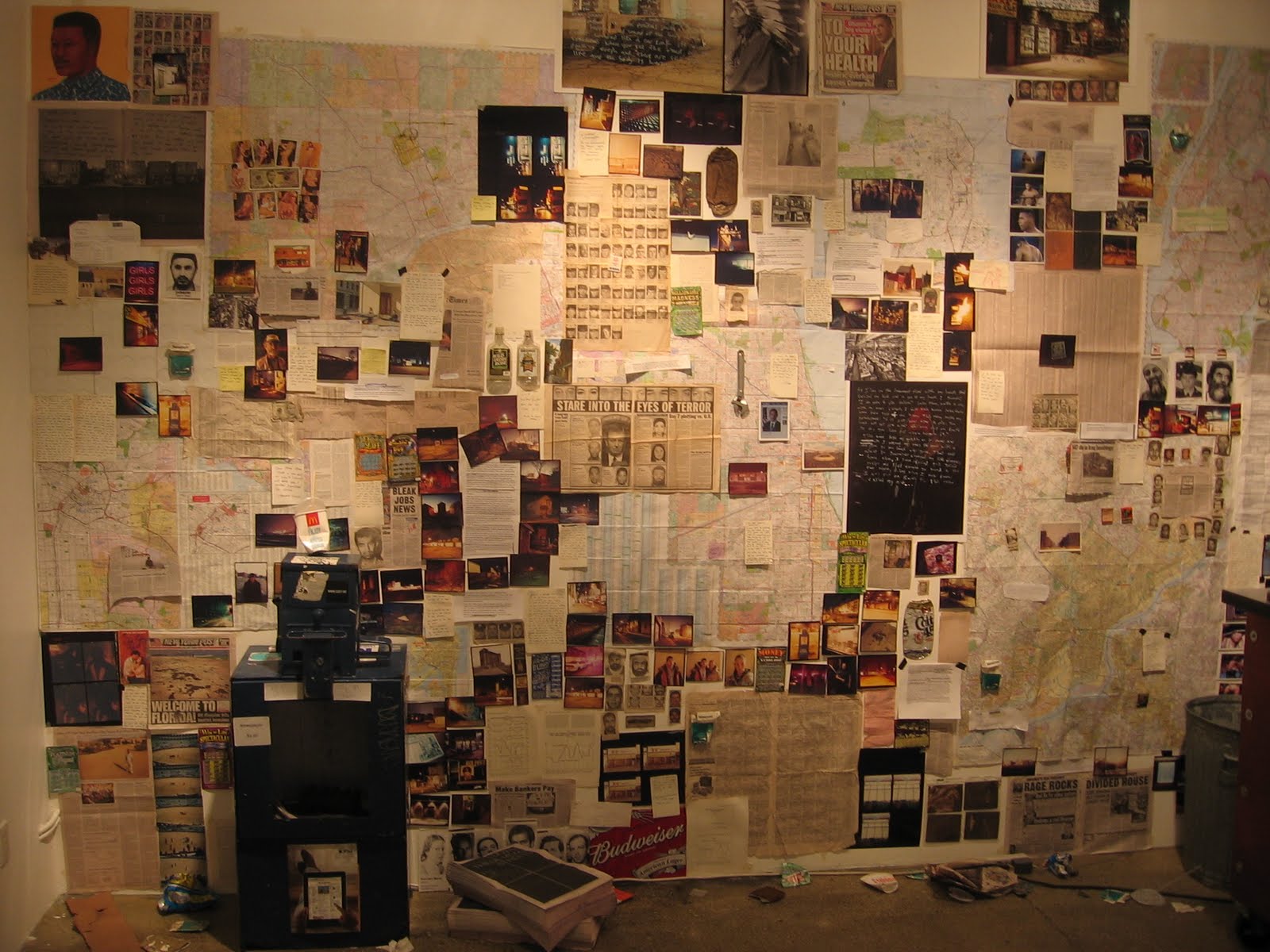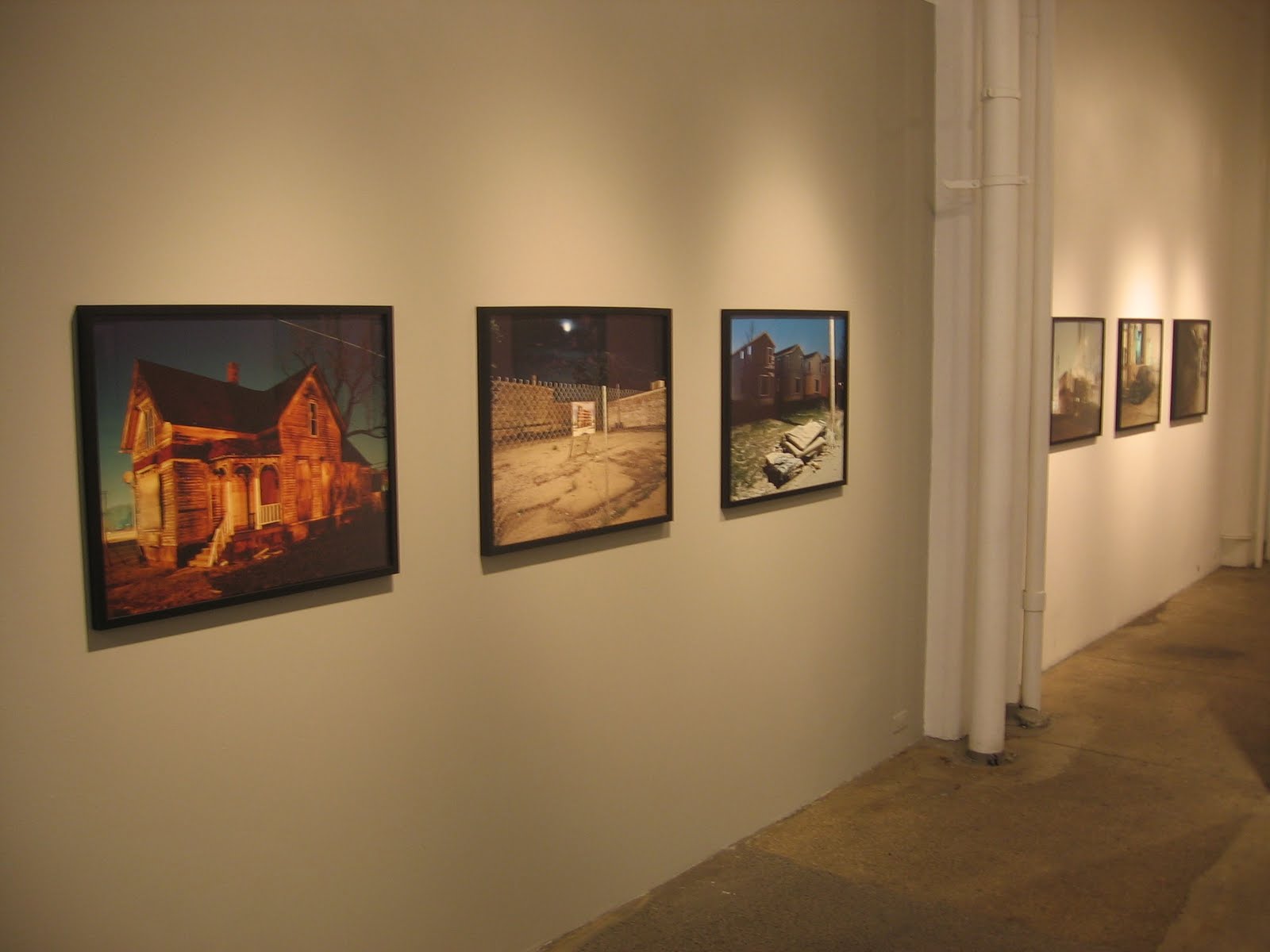 JTF (just the facts): A total of 22 color images, framed in black with no mat, and hung against grey walls in the entry and main gallery spaces. The pigmented ink prints come in two sizes (or reverse): 16×20 (in editions of 5+2AP) and 24×30 (in editions of 3+2AP). While no dates were given on the gallery checklist, I think we can safely assume that all of these images were made in the past few years. A 16-page tabloid newspaper in both color and black and white is available from the gallery for $5. (Installation shots at right.)
JTF (just the facts): A total of 22 color images, framed in black with no mat, and hung against grey walls in the entry and main gallery spaces. The pigmented ink prints come in two sizes (or reverse): 16×20 (in editions of 5+2AP) and 24×30 (in editions of 3+2AP). While no dates were given on the gallery checklist, I think we can safely assume that all of these images were made in the past few years. A 16-page tabloid newspaper in both color and black and white is available from the gallery for $5. (Installation shots at right.)
Comments/Context: The plight of our inner cities isn’t exactly a new topic in the world of contemporary photography. Many photographers have pointed their cameras at our abandoned houses, empty streets, and broken neighborhoods, most with an air of clinical detachment or meticulous anthropological documentation, searching for abstract photographic beauty or subtle irony hidden amid the grit. Will Steacy’s photographs, taken at night while wandering in the transitional zones between airports and urban areas in some of America’s best known cities, have no such comfortable, eyes-averted distance. They are right up in your face, with a level of aggressive confrontation that is unavoidable. This is an artist with a chip on his shoulder, willing to take some risks to jolt us out of our stupor, combining the eye of an investigative reporter with the angry heart of a dramatic story teller.
 One wall in the reception area of the gallery is blanketed in a dense, highly personal installation of 3×4 photographs, maps, airline stubs, lottery tickets, news articles, terrorist mug shots, pulp novel covers, flattened beer cans, book pages, plastic booze flasks, matchbooks, taxicab licenses, and other miscellaneous artifacts and ephemera collected along the way during this project, all covered and annotated with scrawled handwriting. It’s the kind of manic, obsessive, intelligent, rage-filled wall that you normally find in the basement lair of a serial killer in the movies. It weaves failings in banking, joblessness, wars, terrorism, foreclosures, broken education, and unaffordable health care together with fear, neglect, and devastation, all wrapped up with an unforgiving rawness that is entirely mesmerizing and real. The wrench Steacy used for protection during his night time shoots is collaged next to his old labor union card; a broken newspaper box lies in front, with strewn trash on the floor nearby. It is a harrowing, multi-dimensional portrait of an artist thoroughly annoyed by the destruction of the American Dream and exasperated at our complicit avoidance of seeing what is happening or doing anything about it.
One wall in the reception area of the gallery is blanketed in a dense, highly personal installation of 3×4 photographs, maps, airline stubs, lottery tickets, news articles, terrorist mug shots, pulp novel covers, flattened beer cans, book pages, plastic booze flasks, matchbooks, taxicab licenses, and other miscellaneous artifacts and ephemera collected along the way during this project, all covered and annotated with scrawled handwriting. It’s the kind of manic, obsessive, intelligent, rage-filled wall that you normally find in the basement lair of a serial killer in the movies. It weaves failings in banking, joblessness, wars, terrorism, foreclosures, broken education, and unaffordable health care together with fear, neglect, and devastation, all wrapped up with an unforgiving rawness that is entirely mesmerizing and real. The wrench Steacy used for protection during his night time shoots is collaged next to his old labor union card; a broken newspaper box lies in front, with strewn trash on the floor nearby. It is a harrowing, multi-dimensional portrait of an artist thoroughly annoyed by the destruction of the American Dream and exasperated at our complicit avoidance of seeing what is happening or doing anything about it.
 Nearly all of the larger photographs in the main gallery are awash in the malignant glare of acidic streetlights. They depict bullet holes, cigarette butts, boarded up housing projects, homeless people, gutter trash, and vacant lots, but they do so without voyeuristic sentimentality or cheap sensationalism. Even though Steacy is an outsider to these particular communities, his viewpoint comes from within, more in a social documentary style steeped in everyday realism. He has chosen emblematic scenes that have a formal clarity, with an added edge of anxiety and danger. A coffee cup lies inside a broken newspaper vending machine, a bus bench is reduced to two sawed off stubs, a purse lies abandoned on the sidewalk, and a fence encircles a dark brick housing facility, a barrier for both those wanting to get in and those wanting to get out. The sense of being out-in-the-open and alone is palpable.
Nearly all of the larger photographs in the main gallery are awash in the malignant glare of acidic streetlights. They depict bullet holes, cigarette butts, boarded up housing projects, homeless people, gutter trash, and vacant lots, but they do so without voyeuristic sentimentality or cheap sensationalism. Even though Steacy is an outsider to these particular communities, his viewpoint comes from within, more in a social documentary style steeped in everyday realism. He has chosen emblematic scenes that have a formal clarity, with an added edge of anxiety and danger. A coffee cup lies inside a broken newspaper vending machine, a bus bench is reduced to two sawed off stubs, a purse lies abandoned on the sidewalk, and a fence encircles a dark brick housing facility, a barrier for both those wanting to get in and those wanting to get out. The sense of being out-in-the-open and alone is palpable.
In some ways, this isn’t the easiest work to like. It holds up a mirror to a world we have created for ourselves that isn’t particularly pretty. What I find most memorable is that there is a sense of fighting spirit in these pictures; the artist has dug deeply and worked hard to tell these sometimes bleak and unforgiving stories. As result, they have power and intensity that is absent in other similar drive-by projects of ruined cities. Steacy has immersed himself in this neglected and forgotten part of our world, made it his own, and is clearly taking it personally.
 Collector’s POV: The works in this show are priced in rising editions. The 16×20 works begin at $1200 and rise to $2200; the 24×30 works begin at $2000 and rise to $3500. Steacy’s work is not yet available in the secondary markets, so gallery retail is likely the only option for interested collectors at this point.
Collector’s POV: The works in this show are priced in rising editions. The 16×20 works begin at $1200 and rise to $2200; the 24×30 works begin at $2000 and rise to $3500. Steacy’s work is not yet available in the secondary markets, so gallery retail is likely the only option for interested collectors at this point..
- Artist site (here) and blog (here)
- Review: New Yorker (here)
- Interviews: Conscientious (here), BOMBlog (here)
- Feature: Conscientious (here)
Through July 30th




